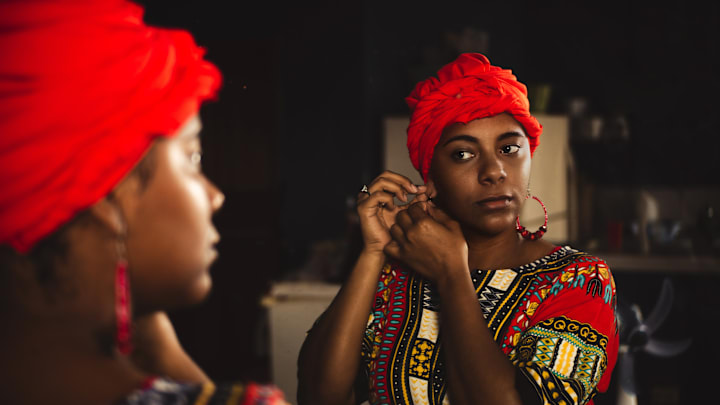In Latin America, Afro-Descendant communities were typically formed by escaped or freed enslaved people who sought refuge in remote areas. They have survived centuries of colonization, exploitation, and oppression. And while they have preserved their cultural traditions and languages, many groups experience poverty and lack access to resources, and climate change, industrialization, and land dispossession from their governments threaten their survival. Activists continue to advocate for the rights of these groups. These Afro-Latinx communities have long, resilient histories; here are eight you should know about.
1. Garifuna // Honduras, Guatemala, and Nicaragua
The Garifuna are the descendants of indigenous Caribbean groups and escaped enslaved Africans. In the late 19th century, they migrated to Nicaragua, Guatemala, and neighboring countries in Central America, where they often worked in construction, agriculture, and logging.
The Garifuna were able to preserve their customs and languages by creating independent coastal communities. The passage of Law 445 in 2005 granted the Garifuna in Nicaragua land rights; this autonomy has continued to help protect their culture and heritage.
2. Miskito // Honduras and Nicaragua
The Miskito Kingdom—which stretched along the coasts of modern Nicaragua and Honduras—was internationally recognized from 1633 until 1894, when Nicaragua invaded and seized power. Now, Miskito people are divided by the border between the two countries. Many of those on the Nicaraguan side migrated to Honduras after conflicts with the country's Sandinista government in the 1980s. Today, they mainly subsist by raising cattle and poultry, fishing, and other forms of agriculture. They primarily speak Miskito Coast Creole, English, and Spanish.
3. Malagasy // Peru
The north Peruvian coast and southern coastal cities of Ica and Nazca are home to Peru’s Afro-Descendant communities, the largest group of which is the Malagasy. During colonial times, they were brought to Peru to work on plantations; today, their main source of income is agriculture and artisanal work. In 2009, Peru formally apologized to its citizens of African descent for centuries of oppression.
4. Palenques // Colombia and Venezuela
The Palenques in Colombia originated from a community created by freedom-seeking enslaved people from Cartagena. The Spanish declared the Palenque a sovereign people in the 18th century. Today, they mainly live in Palenque de San Basilio in Northern Colombia, as well as neighboring parts of Venezuela. In 2005, UNESCO declared the area a Masterpiece of the Oral and Intangible Heritage of Humanity site.
Palenque is also the name of the language the communities speak. It’s a combination of European languages including Spanish, Portuguese, English, and French, as well as African Bantu languages. The number of remaining Palenque speakers is unknown, and the language’s use continues to decrease.
5. Wayuu // Colombia and Venezuela
The Wayuu people, “the people of the sun, sand, and wind,” are located in the Guajira peninsula of Venezuela, which borders Colombia. Their numbers are estimated to be in the hundred-thousands. Historically, their income depended on agriculture and fishing. Today, the Wayuu continue to fight for the preservation of and rights to their homelands.
6. Cambacuá // Paraguay
The Cambacuá are located east of Paraguay’s capital, Asuncion. Former Uruguayan leaders displaced most of the Cambacuá from their land in the 20th century to create new buildings; additionally, the loss of agricultural work caused a mass exodus to urban areas [PDF]. The current Canbacuá population has declined, though the communities are working to preserve their ethnic roots, despite the land dispossession and government erasure.
7. Quilombolas // Brazil
Freedom-seeking enslaved people formed communities called Quilombos in secluded areas of Brazil. The largest settlement was Palmares—with a population of roughly 20,000 people—which the Portuguese conquered at the end of the 17th century.
Quilombola descendants have persisted despite colonization: The Quilombola Program has pinpointed more than 3500 communities, some of which now have the official titles to their land. These families and villages have preserved their cultural traditions, and they speak African-influenced dialects elders have passed down through generations.
8. Neo-Taino // Puerto Rico, Cuba, and the Dominican Republic
Before the Spanish arrived, the Taino were the largest indigenous group in the Caribbean—their population is believed to have been in the millions. They lived in log houses and had hierarchical government and religious systems, and they crafted goods such as pottery, baskets, and jewelry.
Due to disease and enslavement, colonization reduced the population to mere thousands by the mid-16th century. Today, Afro-Caribbeans have the right to self-determine as Taino; this is known as the Neo-Taino movement in Puerto Rico.
